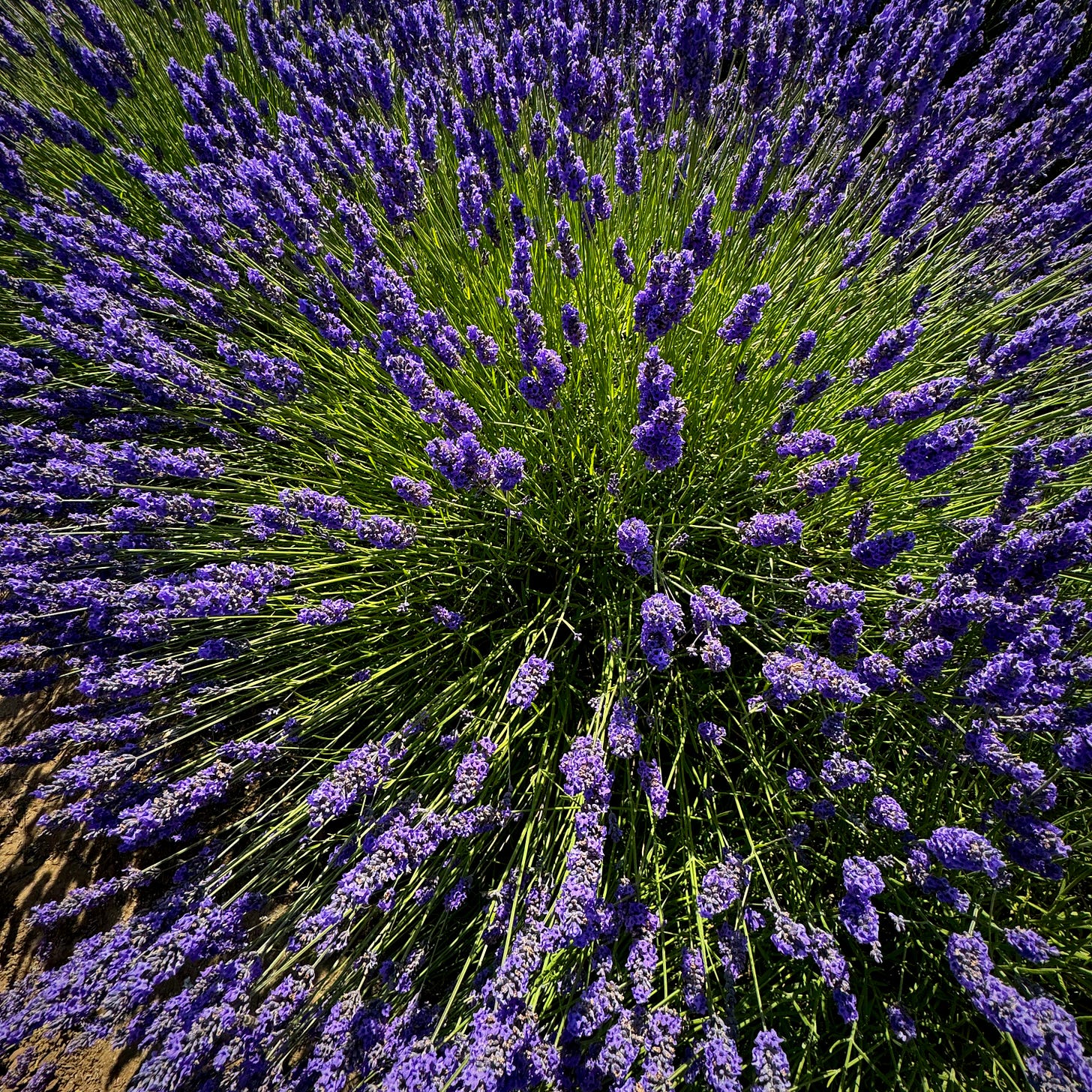It is no secret to my immediate family that I am very fond of lavender soliflores. In the old days, I used Caldey Island Lavender. Then the monks had it reformulated and screwed it up completely. Of late, I’ve fallen back on Atkinson’s English Lavender, which I like a lot, partly because I can buy it in satisfyingly huge bottles (620 ml). It is made in Italy. I have no idea whether the lavender in it comes from England, Provence, Spain, Ukraine, or Bulgaria (a major producer), but it smells great to me. I say “to me” because I am completely anosmic to the musk they added to the formula. I only smell a long-lasting lavender, whereas Tania also smells an overpowering musk. We finally cleared up this misunderstanding recently, and I’ve been a bit more careful with the amounts since.
Some of the world’s best lavender used to come from England. There is a Lavender Hill in South London and fields dotted all over Southern England, many in Norfolk. Last week we visited Norfolk Lavender, a farm that produces it. It has a garden showcasing a range of species, hybrids, and varietals. I expected a vast array of lavender products in the shop but was disappointed to find only some forlorn shampoos and a solid perfume stick on two small shelves among a flood of tchotchkes. The lavender field looked great, crazy purple among the greenery, with a bee on practically every stalk, adding up to a steady high-voltage transformer buzz.
As it happens, the amazing people at Enfleurage sent a mailshot about lavender three weeks ago and listed a few different ones on offer. Enfleurage are BS-free. They don’t swan around in Indiana Jones outfits and tell you they’ve traipsed through the Darien Pass to bring back 1 ml of Boronia absolute distilled over orca ambergris, although Trygve Harris did spend years in Oman figuring out the best incense1. Their stuff is 24-carat excellent. I asked for samples.
Bless them, they sent five different extracts. The little bag they were in smelled divine. My entire knowledge of botany can be written on one non-commemorative postage stamp, but I can read labels if I have my glasses on. Here goes, lavender lovers.
It goes almost without saying that all these lavenders are intense and satisfying, more powerful than expected. You can smell them already on the necks of the sealed bottles, which makes me wonder how many of the little aromatherapy lavenders you see elsewhere on display are thoroughly diluted. The differences I list below are mostly second-order effects. My respect for the technical perfumers who maintain supply consistency at oil houses by selecting and blending lavenders, always high, is now through the roof. I make no claims as to which would work best in composition, because that works in mysterious ways.
Lavender Fine (France)
This one is basically waving at you and saying “perfume ingredient here!” in a French accent. It has a slight banana ester note which immediately suggests adding vanilla, etc. I feel I recognise it from long acquaintance with Pour un Homme (Caron). I can see why Caron’s tag line for PuH was “les plus belles lavandes.”
Wild Lavender (France)
The almost metallic, coriander-like top dissipates fairly quickly, revealing a slightly roasted, almost meaty note in the background.
Lavandin Super (France)
Organic lavandin x hybrida. Lavandin has a more camphoraceous note (see cajuput, Tiger Balm, etc), which I generally like better than lavande. If that’s the aspect of lavender you like, this one is great, with a slight caramellic note in the background.
Spike Lavender (Spain)
This is latifolia lavender, less sweet and a touch more camphoraceous than angustifolia, less coherent and refined than the lavandin, but beautifully clean and powerful.
Lavender Maillette (France)
This varietal was created by a grower named Maillette in the 1950s. Smell it pure on a strip, and the weird top note will make you wonder why it is the dominant varietal for perfumery use, with its strong isovaleric (cheesy valerian) angle. When that note dissipates, the remainder is an intense, true-blue lavender with a dry, woody, timber-merchant background, plus a touch of citrus.
My next project is to figure out which of these I would dilute, say, 1:10 with perfumery solvent of 98% alcohol, add a few percent of an odorless C20 fixative like phytol, and use every day as a pure soliflore. As my daughter says when faced with a large range of choices, e.g. ice cream, “Why not all?”
Her Omani incense is so soft and mild that you can chew it like gum and it will nix most stomach inflammation within hours. Incidentally, the power of resins is such that terminal alcoholics in Italy (as did my late mother) drink Fernet-Branca because the myrrh it contains saves them from gut-rot.





Totally fascinated by this and glad to know about this supplier for their large and interesting range. I've used Lavender a lot as aromatherapy, but have decided to hold back for a few weeks after having read near-plausible studies about its ability to disrupt hormones, for example, https://factor.niehs.nih.gov/2019/9/feature/3-feature-lavender#:~:text=%E2%80%9CLO%20%5Blavender%20oil%5D%20is,senior%20author%20Kenneth%20Korach%2C%20Ph.
I love wearing Pour un Homme de Caron. It's my favourite lavander scent.
I have never tried Atkinson’s English Lavender but I was on the magnificent Eau my soul livestream where this fragrance was mentioned. Your and Tania's perception to this scent was one of my favourite moments :)